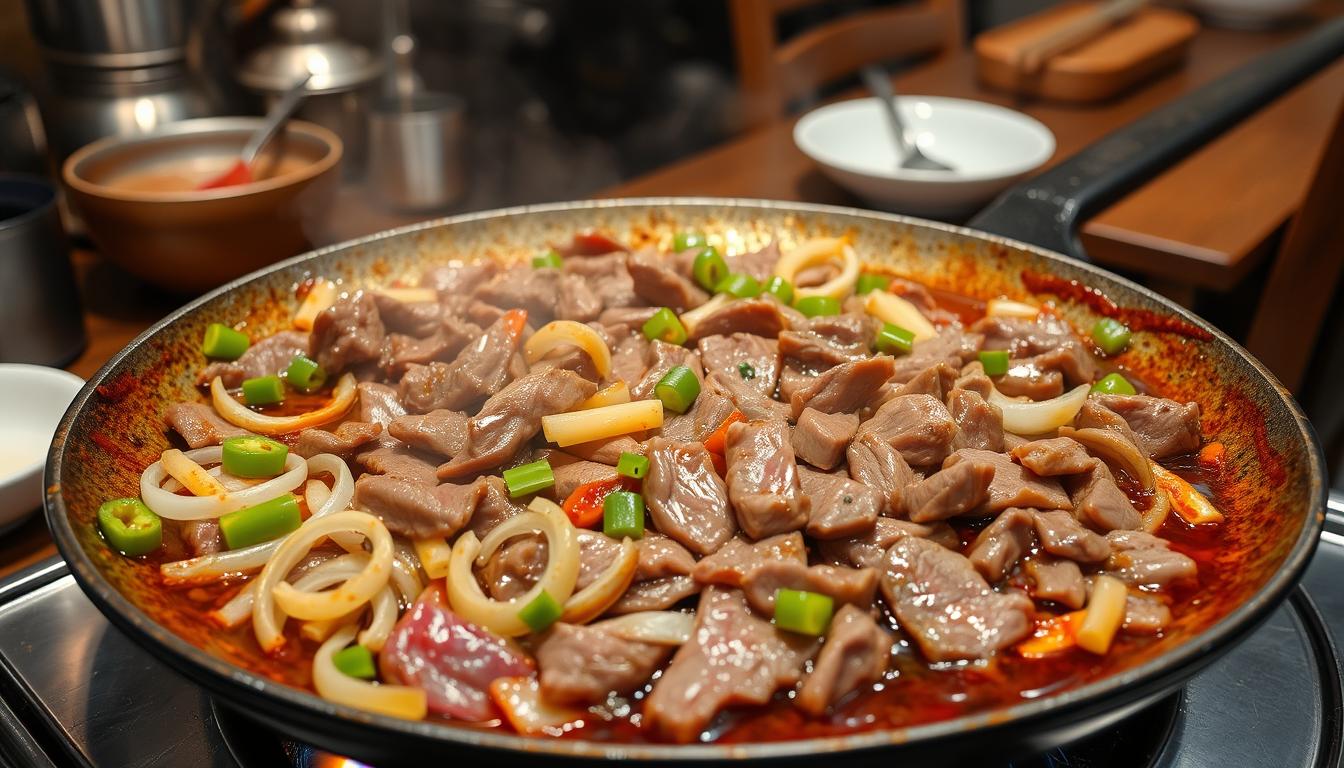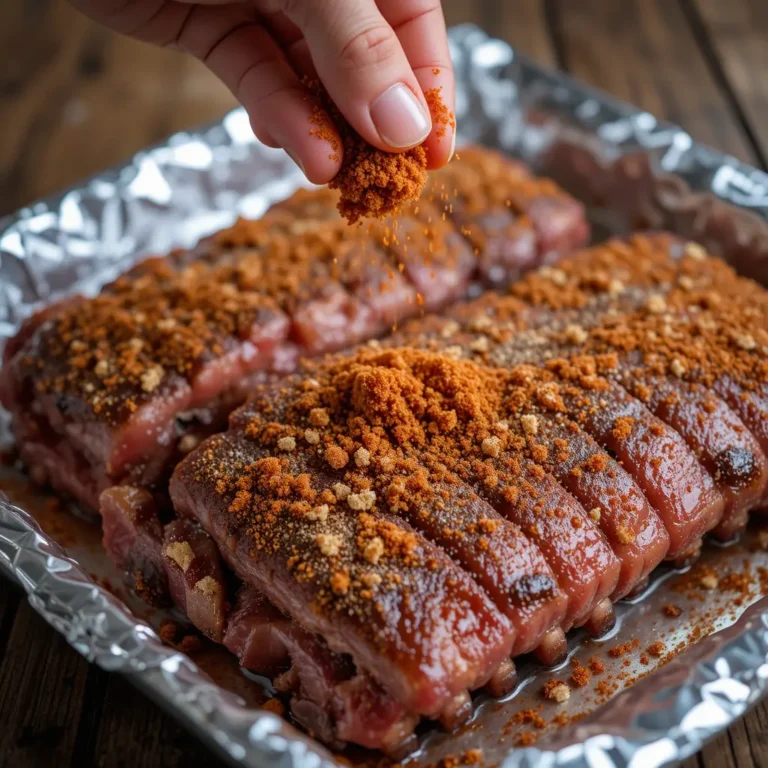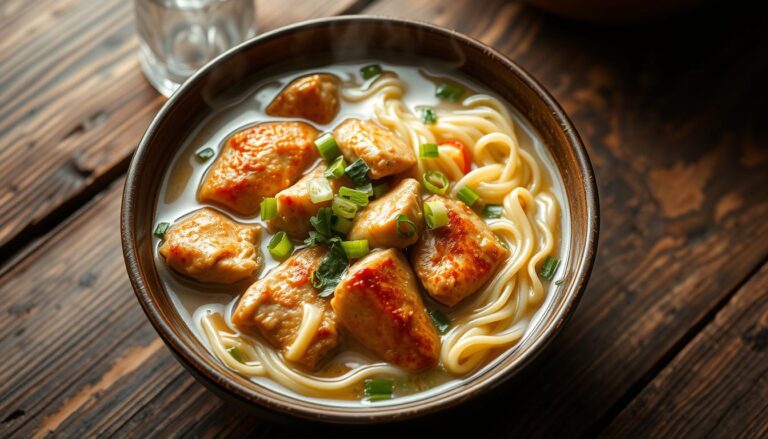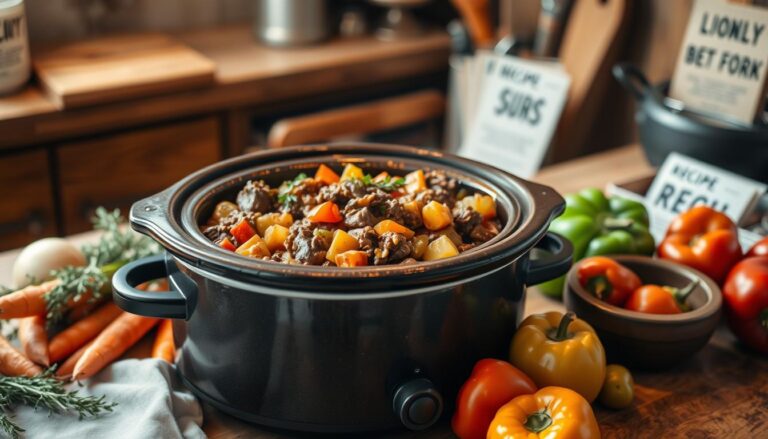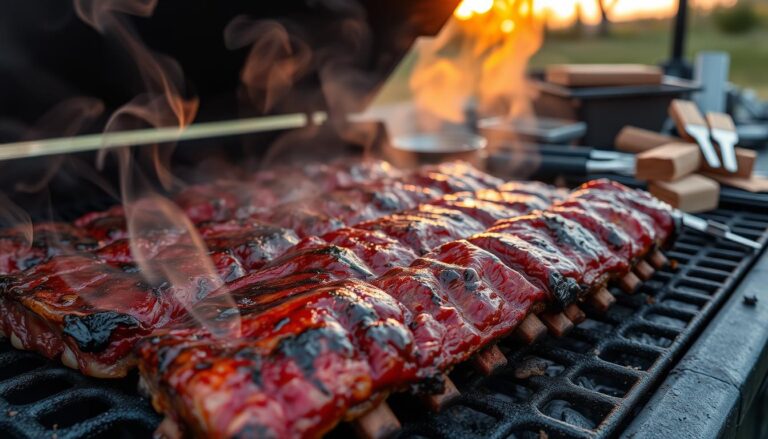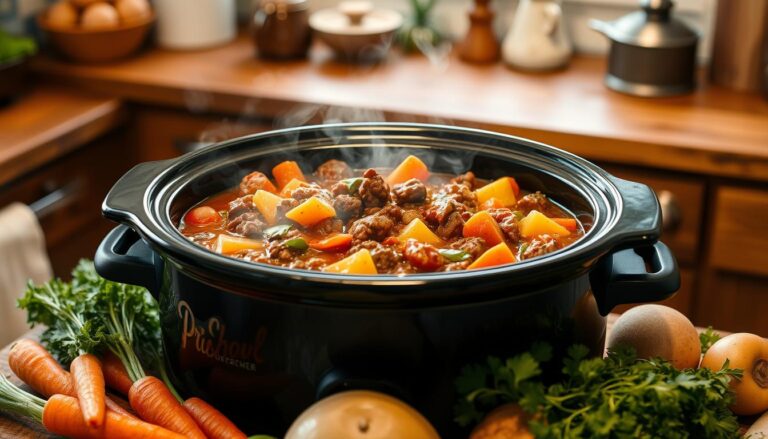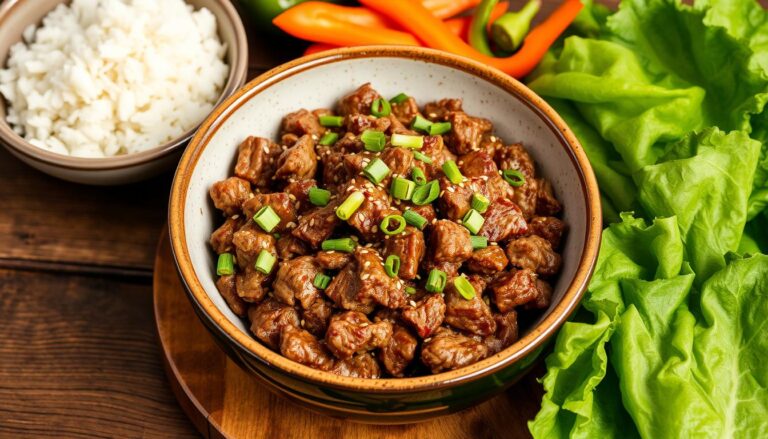Easy Bulgogi Recipe: savor the Flavors of Korea
The first time I tasted Korean beef bulgogi, it changed my cooking world. The sizzling, tender meat was full of rich flavors. It felt like I was in Seoul’s lively streets.
This marinated bulgogi recipe is more than a meal. It’s a trip through Korean cooking traditions. It will wake up your taste buds and make you love Korean food.
Bulgogi means “fire meat” and it’s a big deal. It’s all about flavor, skill, and culture. This easy bulgogi recipe lets you make top-notch Korean BBQ at home, no matter your cooking level.
Table of Contents
Key Takeaways
- Bulgogi is a traditional Korean dish featuring thinly sliced, marinated beef
- Boneless ribeye steak provides the best flavor and tenderness
- Marinating overnight enhances the depth of flavor
- Cooking time is quick—typically 3-5 minutes over high heat
- Perfect for home cooking and impressing dinner guests
The Rich History and Cultural Significance of Bulgogi
Korean beef bulgogi has a deep history that spans thousands of years. It’s more than a meal; it’s a symbol of Korea’s rich culinary traditions. It shows how Korean food has evolved over time.
The story of bulgogi begins in the ancient Goguryeo era, from 37 BC to 668 AD. Back then, it was called maekjeok. This referred to meat grilled on skewers, a simple yet tasty method.
Origins in Goguryeo Era
In its early days, bulgogi was a simple yet clever way to cook meat. The Goguryeo people started using:
- Skewer-based meat preparation
- Initial marination techniques
- Open-flame cooking methods
Evolution Through Korean Dynasties
The Joseon Dynasty (1392-1897) was a turning point for bulgogi. It changed from maekjeok to neobiani. This meant moving from skewers to grates for cooking. The nobility also made the marinades and cooking methods more complex.
Modern-Day Cultural Impact
“Bulgogi represents not just a dish, but the soul of Korean culinary tradition.”
Now, Korean beef bulgogi is loved worldwide. It shows the depth and richness of Korean food. It connects people across generations with its flavors and cooking methods.
The name “bulgogi” means “fire meat,” which fits its grilling method perfectly. Its rise from a local favorite to a global dish highlights its cultural importance.
Understanding the Perfect Cut of Beef for Traditional Bulgogi
Choosing the right beef is key for a true beef bulgogi recipe. Ribeye steak is the top choice for Korean BBQ. It has lots of marbling, making it juicy and full of flavor.
Here are the best cuts for bulgogi:
- Ribeye: Premium cut with superior marbling
- Sirloin: Budget-friendly alternative
- Tenderloin: Buttery texture
- Flank steak: Lean option requiring thorough marination
The secret to great beef slices is in how you cut them. Slice against the grain, making pieces about 1/8 inch thick. This makes the meat tender and helps it soak up marinade well.
Pro tip: Choose well-marbled beef to enhance flavor and retain moisture during high-heat cooking.
Look for USDA Prime and Choice grades for top-notch beef. The right cut will make your Korean BBQ beef amazing. It will give you a real taste of Korea in your kitchen.
Essential Ingredients for an Authentic Korean Bulgogi
Making the perfect bulgogi starts with picking the right ingredients. It’s a journey into Korean cuisine. You’ll learn about the flavors that make bulgogi special.
Key Marinade Components
The marinade is the heart of bulgogi. It needs:
- Reduced-sodium soy sauce
- Brown sugar for sweetness
- Sesame oil for flavor
- Grated Korean or Asian pear
- Rice cooking wine
- Minced garlic
- Grated fresh ginger
Traditional Asian Seasonings
Korean seasonings add depth to bulgogi. Asian pear tenderizes and sweetens. Garlic and ginger give a strong flavor, typical of Korean cooking.
“The secret to great bulgogi is in the balance of sweet, savory, and umami flavors” – Korean Culinary Experts
Specialty Korean Ingredients
For more flavor, try these Korean seasonings:
- Gochugaru (Korean red pepper flakes)
- Gochujang (Korean red pepper paste)
- Sesame seeds
A bulgogi serving has about 150 calories. It has 4g of carbs, 20g of protein, and 6g of fat. Choosing the right ingredients makes it tasty and healthy.
Easy Bulgogi Recipe: Step-by-Step Instructions
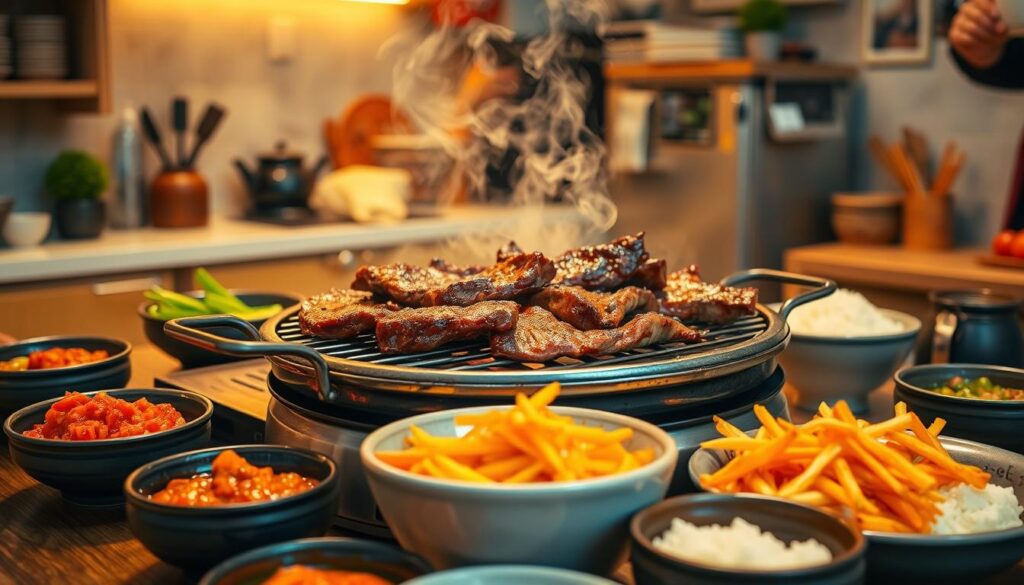
Making a real Korean BBQ at home is simpler than you think. This easy bulgogi recipe will turn your kitchen into a place of amazing flavors. It will wow your family and friends.
To begin your bulgogi journey, gather these essential ingredients:
- 1 lb boneless ribeye steak
- 1/4 cup soy sauce
- 2 tablespoons honey
- 2 tablespoons sesame oil
- 3 cloves minced garlic
- 1 tablespoon grated ginger
- Sesame seeds for garnish
The key to a great bulgogi recipe is in the prep. Slice the beef thinly against the grain for tenderness and flavor. Use a sharp knife and slightly frozen meat for the best slices.
“The art of bulgogi is in the details of preparation and marination” – Korean Culinary Tradition
Marination is key for deep flavors. Mix your marinade well, then cover the beef. Refrigerate for at least an hour, or better, overnight, for full flavor absorption.
When cooking time comes, heat a skillet or grill to high. Cook the beef in batches, letting each piece get caramelized. It takes about 5-7 minutes total.
Present your bulgogi hot, topped with sesame seeds and green onions. Serve with steamed rice and kimchi for a true Korean BBQ at home.
Mastering the Art of Slicing Beef for Bulgogi
Preparing the perfect bulgogi starts with expert meat preparation. Slicing beef for bulgogi requires precision and technique. This ensures tender, flavorful results that will impress your dinner guests.
Proper Cutting Techniques
When preparing thinly sliced beef for bulgogi, follow these essential guidelines:
- Use a razor-sharp knife for clean, precise cuts
- Always cut against the grain of the meat
- Aim for consistent slice thickness of approximately 1/8 inch
Thickness Guidelines for Maximum Tenderness
The key to bulgogi meat preparation lies in achieving the perfect slice thickness. Thin slices of beef should be uniform. This ensures even cooking and optimal texture.
| Slice Thickness | Cooking Time | Texture Result |
|---|---|---|
| 1/8 inch | 2-3 minutes per side | Tender and juicy |
| 1/4 inch | 3-4 minutes per side | Slightly chewier |
Pro Tips for Perfect Slicing
Professional chefs recommend a simple trick for easier slicing: partially freeze your beef for 20-30 minutes before cutting. This technique makes slicing thinly sliced beef much more manageable. It helps create more consistent cuts.
“The secret to great bulgogi is in the preparation of the meat” – Korean Culinary Expert
Remember that practice makes perfect when it comes to slicing beef for bulgogi. With time and patience, you’ll develop the skill to create restaurant-quality meat slices right in your own kitchen.
Creating the Perfect Bulgogi Marinade
Making a great bulgogi marinade needs care and a grasp of Korean tastes. Your marinade will turn regular beef into a dish that truly shows off Korean cooking.
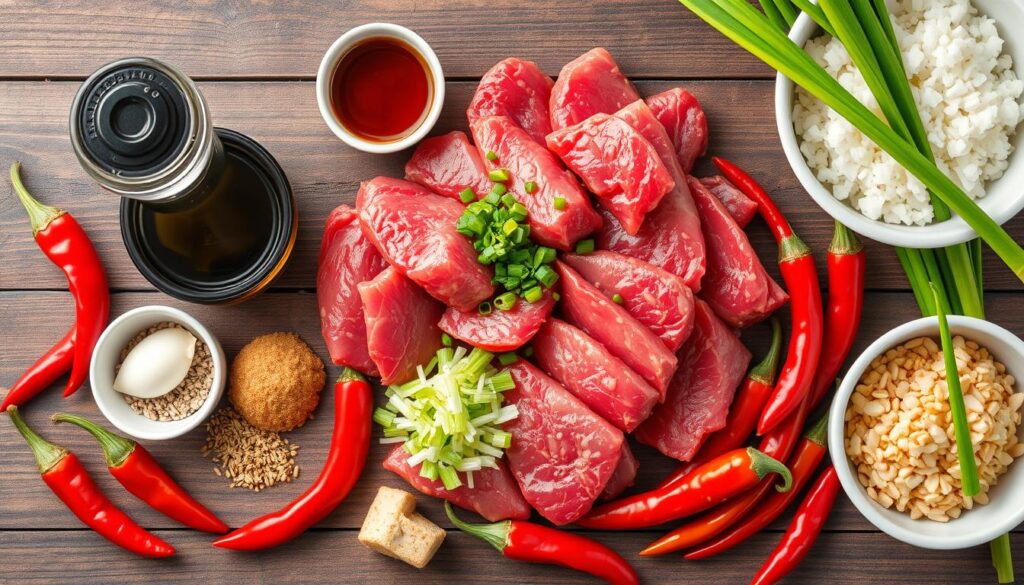
The key to a top bulgogi marinade is mixing sweet, savory, and umami tastes. Let’s look at the main parts that make your bulgogi stand out:
- Reduced-sodium soy sauce (1/3 cup)
- Brown sugar (2 tablespoons)
- Sesame oil (3 tablespoons)
- Grated Asian pear (1/2 large)
- Mirin (rice wine, 2 tablespoons)
- Minced garlic (2 cloves)
- Grated ginger (2 tablespoons)
- Optional: Gochujang (1 tablespoon for heat)
Every ingredient is important for a deep and true bulgogi marinade. The Asian pear tenderizes the meat and adds sweetness. Sesame oil brings a deep, nutty flavor that makes the dish better.
“A perfect marinade is like a symphony – every ingredient must harmonize.” – Korean Culinary Tradition
| Ingredient | Purpose | Quantity |
|---|---|---|
| Soy Sauce | Salty base | 1/3 cup |
| Brown Sugar | Sweetness | 2 tablespoons |
| Sesame Oil | Nutty flavor | 3 tablespoons |
| Asian Pear | Tenderizer | 1/2 large |
Pro tip: For the best taste, marinate your beef for at least 20 minutes. But marinating overnight will give you the best results. When you’re ready to cook, grill or stir-fry your bulgogi for 4-5 minutes on each side. This will make it tender and delicious.
Professional Tips for Tenderizing and Marinating
Mastering bulgogi marinating tips is key for a real Korean BBQ experience. Turning tough beef into tender, flavorful food needs careful prep and technique.
There are several ways to tenderize beef for bulgogi. These methods make your cooking go from good to great. Chefs know that getting that tender texture is all about the prep.
Optimal Marination Strategies
For top Korean BBQ results, try these marinating tips:
- Marinate beef for at least 12 hours to soak up flavors
- Keep it in an airtight container to keep flavors in
- Refrigerate to stay safe
- Make meat slices about ⅛-inch thick for even cooking
Temperature Considerations
Temperature is key for tender beef. Before cooking, let marinated meat sit at room temperature for 30 minutes. This helps it cook evenly and get those tasty, caramelized edges.
Smart Storage Methods
Right storage keeps bulgogi fresh and tasty. Store marinated beef in a sealed container in the fridge for up to 48 hours. Before cooking, drain off extra marinade and pat the meat dry for better searing.
“The secret to great bulgogi is patience and precision in marinating.” – Korean BBQ Master
Cooking Methods and Techniques for Bulgogi
Learning how to cook bulgogi is all about mastering Korean BBQ techniques. These methods are key to getting the best flavor out of this dish. The way you grill bulgogi can really change its taste and texture.
There are different ways to cook bulgogi, each with its own benefits. Here are the main methods to get that restaurant-quality taste:
- Pan-Frying: Use a hot skillet to create caramelized edges
- Grilling: Capture smoky flavors with direct heat
- Barbecuing: Develop rich, deep flavor profiles
When grilling bulgogi, keep the heat at medium-high, between 450° to 550°F. Cook each side for 2-3 minutes to get it just right. It’s important to not overcrowd the grill and to flip it only when needed to keep the juices in.
| Cooking Method | Temperature | Cooking Time |
|---|---|---|
| Pan-Frying | High Heat | 3-5 minutes |
| Grilling | 450-550°F | 2-3 minutes per side |
| Barbecuing | Medium-High | 4-6 minutes total |
“The secret to perfect bulgogi lies not just in the marinade, but in the cooking technique.” – Korean BBQ Master
Pro tip: Let the meat rest for a few minutes after cooking. This helps keep the juices in, making the bulgogi tender and full of flavor.
Traditional Serving Suggestions and Side Dishes
Serving bulgogi is more than just putting meat on a plate. It’s about creating a feast that excites all your senses. Korean BBQ accompaniments turn your meal into a colorful and tasty experience.
When you make bulgogi, you get to enjoy many side dishes from Korean cuisine. These sides, called banchan, usually include 15 different small plates. They add variety and flavor to your meal.
Classic Korean Accompaniments
Your bulgogi feast can include many traditional sides. These sides make your meal even better:
- Kimchi: A fermented cabbage dish full of probiotics
- Steamed rice: A must-have in Korean meals
- Japchae: Sweet potato noodles with veggies
- Pickled radish: A tangy dish to clean your palate
- Soybean sprout salad: Earthy and refreshing
Modern Serving Ideas
Modern Korean cuisine brings new ways to enjoy bulgogi:
- Wrap in fresh lettuce leaves
- Create bulgogi tacos
- Use in bibimbap bowls
- Make bulgogi sandwiches
Beverage Pairings
Choose drinks that match the rich flavors of bulgogi:
- Korean rice wine (soju)
- Traditional green tea
- Light beer
Pro tip: Garnish your bulgogi with sesame seeds and sliced green onions for an authentic touch!
Conclusion
Your journey into authentic Korean cuisine ends with this easy bulgogi recipe. You’ve learned how to pick the right meat, slice it perfectly, and marinate it just right. This way, you can make Korean BBQ at home that tastes like it’s from a restaurant.
Bulgogi is very flexible. You can stick to traditional ways of serving it or try new, modern styles. This lets you get creative with your cooking.
Learning to make bulgogi is more than cooking a meal. It’s diving into a deep culinary tradition. With just 2 pounds of ribeye steak and simple ingredients like sweet Korean soy sauce, you can make a special dinner. Whether you grill or use a stovetop, the most important thing is to respect the ingredients and methods.
This easy bulgogi recipe opens up a world of possibilities. You can put it in sandwiches or serve it with rice. Your new skills show that amazing food can bring the world to your table. Enjoy the journey, relish each bite, and celebrate the delicious outcome of your cooking adventure.
FAQ
What cut of beef is best for bulgogi?
Boneless ribeye steak is perfect for bulgogi. It’s tender and has a rich flavor. When sliced thinly, it captures the authentic Korean bulgogi texture.
How long should I marinate bulgogi?
Marinate the beef for at least 30 minutes. But, marinating overnight in the fridge is best. This lets the marinade fully penetrate and tenderize the meat.
Can I make bulgogi without an Asian pear?
Yes, you can use kiwi, apple, or a bit of honey instead of Asian pear. The goal is to add a natural tenderizer and sweetener to the marinade.
What are the best cooking methods for bulgogi?
You can cook bulgogi in three ways: pan-frying, grilling, or barbecuing. Each method gives a unique flavor while keeping the meat tender.
What should I serve with bulgogi?
Serve bulgogi with steamed rice, kimchi, pickled radishes, and lettuce wraps for a traditional meal. For something new, try it in tacos, sandwiches, or bibimbap.
Is bulgogi spicy?
No, traditional bulgogi isn’t spicy. But, you can add Korean red pepper flakes or paste to the marinade for a spicy twist.
How thin should I slice the beef for bulgogi?
Slice the beef about 1/8 inch thick, cutting against the grain. Freezing the meat slightly makes it easier to get even, thin slices.
Can I make bulgogi with a different type of meat?
Yes, you can use chicken, pork, or tofu instead of beef. Just adjust the marinating and cooking times to get the right flavor and tenderness.
How do I store leftover marinated bulgogi?
Keep marinated beef in an airtight container or sealed bag in the fridge. Use it within 2-3 days to keep it fresh and prevent bacterial growth.
Source Links
- Bulgogi (Korean BBQ Beef) – https://mykoreankitchen.com/bulgogi-korean-bbq-beef/satisfies-every-bowl/korea/
- What Kind of Beef to Use for Bulgogi? The Ultimate Guide – https://zappyrecipes.com/what-kind-of-beef-to-use-for-bulgogi/

